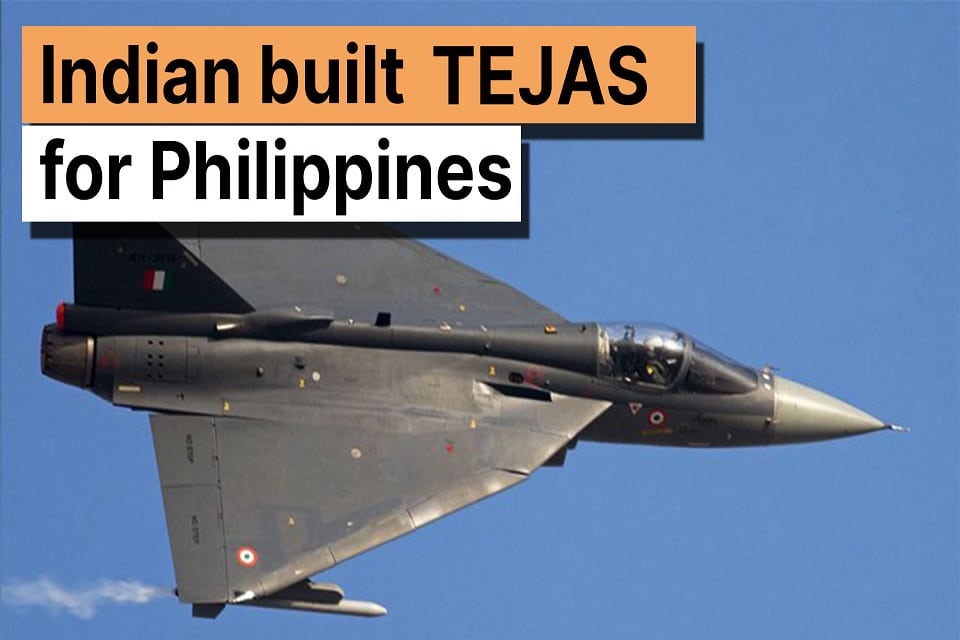Aerospace
India’s HAL offers AESA radar and Brahmos capable Tejas Mk-1A to the Philippines..

The FA 50 is insufficient to the PAF because it has not provided promising results in terms of protection; the Philippines may look for newer fighter jets. The Tejas aircraft, built in India, may be suitable for its requirements because it is already in use by the Indian air force and has proven technology. It was proudly displayed at the most recent airshow, complete with an incredible aerobatic display.
PAF is now looking to expand its fighter fleet and is considering placing orders for 12 more fighter jets under its MRF acquisition programme, for which it is negotiating with Lockheed Martin for the F-16 Block-70 Fighting Falcon and Saab for the JAS 39 Gripen-C. However, Philippine National Defense Secretary Delfin Lorenzana stated that the F-16 cost is prohibitively expensive, fueling speculation that the Gripen will be the front-runner for the contract. However, the recent sale of a Gripen-E to Brazil confirms that its fly-by-unit cost is around $80 million, and even the much smaller C version costs around $60-65 million, prompting PH to consider other options.
HAL is now stepping in to offer Tejas aircraft to PAF, which is expected to happen soon next month. Representatives from the Indian HAL company will pay them a visit and brief them on the aircraft.
The Tejas Mk-1A is an improved version of the Tejas Mk-1 and will be a 4.5 Generation fighter with long range BVR missiles such as Astra Mk-1/2/IR/3 and I-Derby ER, close combat missiles such as R-73, ASRAAM, and Python-5, and anti-ship/land attack cruise missiles such as Subsonic Nirbhay /Hunter ALCM, Hammer and Supersonic Brahmos-NG, laser
It will also have an Elm-2052 / Uttam AESA radar, enhanced electronic warfare capabilities, a pylon-mounted IRST, a more powerful mission computer, dual rack pylons, an aerial refuelling probe, simplified maintenance, and a lower radar signature.
The Tejas Mk1A has a fly-by unit cost of around $42 million, which means it could be used instead of spending nearly $2.43 billion for 12 jets quoted by Lockheed Martin and even more from Saab.
PAF may purchase a fleet of 12 Tejas Mk1A jets for half the price of the deal. One advantage is that both the Tejas Mk1A and the FA-50 are powered by the General Electric F404 afterburning turbofan engine and are compatible with Israeli weapons and sensors, which reduces the additional costs associated with ground crew training and allows Filipino pilots who have completed the FA-50 training programme to easily transition to Tejas Mk1A fighters.
Indian-built fighter jets are also being improved to make them better aircraft, with the latest avionics and weapons packages that will undoubtedly help the Philippines on the battlefield.

Aerospace
Boeing Transfers Rocket Stage to NASA, Paving Way for Human Moon Mission

Boeing has achieved a significant milestone by providing NASA with the second core stage of the Space Launch System (SLS) rocket.
This crucial component, crafted at NASA’s Michoud Assembly Facility (MAF), is set to propel the Artemis II crew into lunar orbit, marking humanity’s return to deep space after a 50-year hiatus.
The monumental Boeing-built rocket stage, the largest element of the Artemis II mission, will embark on a journey aboard the Pegasus barge, traveling 900 miles to NASA’s Kennedy Space Center.
Comparison of two legendary aircraft B777x vs B747 aircraft:Click here
Upon arrival, it will be meticulously integrated with other essential Artemis II components, including the upper stage, solid rocket boosters, and NASA’s Orion spacecraft within the iconic Vehicle Assembly Building. This intricate integration process is a vital step toward the eagerly anticipated Artemis II launch, slated for 2025.
“Boeing-built products helped land humankind on the moon in 1969, and we’re proud to continue that legacy through the Artemis generation,” remarked Dave Dutcher, vice president and program manager for Boeing’s SLS program. “Together, with NASA and our industry partners and suppliers, we are building the world’s most capable rocket and paving the way to deep space through America’s rocket factory in New Orleans.”
NASA, Lockheed Martin Reveal X-59 Quiet Supersonic Aircraft:Click here
The delivery of Core Stage 2 marks a significant achievement in the evolution of the SLS rocket. Towering over 200 feet and powered by four RS-25 engines, this core stage, coupled with two solid-fueled booster rockets, will generate a staggering 8.8 million pounds of thrust. This immense power is crucial to launching Artemis II and future missions into the vast expanse of space.
The SLS rocket stands unparalleled in its capability to transport both crew and substantial cargo to the moon and beyond in a single launch. Its extraordinary capacity will facilitate the delivery of human-rated spacecraft, habitats, and scientific missions to destinations including the moon and Mars, ushering in a new era of space exploration.
-

 Travel1 week ago
Travel1 week agoAir India to Expand US Operations with Three New Routes After a Decade
-

 Travel2 weeks ago
Travel2 weeks agoWhy We Should Avoid These Stamps in a Passport
-

 Airlines1 month ago
Airlines1 month agoInvestigations Reveal Fake Chinese Titanium in Boeing and Airbus Jets
-

 Tech4 weeks ago
Tech4 weeks agoChina’s CATL Plans 1,800-Mile Electric Plane Launch by 2027
-

 Airport3 days ago
Airport3 days agoTop 10 Largest Airports in the World by Size
-

 Aerospace4 weeks ago
Aerospace4 weeks agoChina’s Fighter Jets Turn Wings into Autonomous Drones
-

 Airlines4 days ago
Airlines4 days agoAir India Rolls Out A350s for Delhi-New York JFK and Newark Routes
-

 Defence3 weeks ago
Defence3 weeks agoBoeing Enhances Chinook with New Engines and Block II Upgrades at $96 Million







